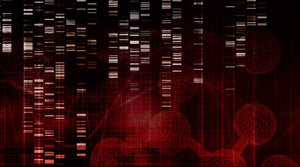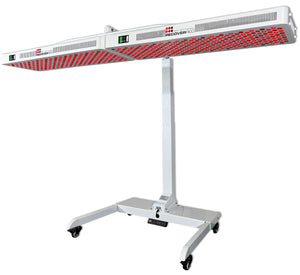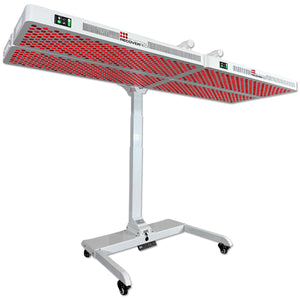"RLT, can be used regularly at home with no risk of rejection, invasive procedures, or significant side effects. Additionally, RLT offers a broader range of benefits."
"Stem Cell treatment can produce faster results for severe tissue damage or chronic conditions. However, it requires professional administration, and access is often very limited. "

In the search for innovative treatments that promote healing and regeneration, two fascinating options have emerged: stem cell therapy and red light therapy (also known as RLT). While these therapies operate in completely different ways, they share common goals—restoring cellular function and promoting tissue repair.
This raises an intriguing question: can red light therapy serve as a more accessible and non-invasive alternative to complex stem cell treatments?
While it’s obvious that red light therapy and stem cell therapy are quite different, the question has tons of potential, especially when you factor in the relative accessibility and affordability of red light therapy devices.
For starters, we need to better understand each of these therapies, what they do, and how they do it. For instance, stem cell therapy.
Stem cell therapy involves injecting younger, healthier cells into damaged tissues to regenerate and repair them. However, RLT works by using natural light to stimulate the body’s own cells to function more efficiently.
To put it in automotive terms, the former is a complete engine replacement, while the latter is more like a tune-up. The experts at Recover Red often say that full-body or “targeted red light therapy” is the best way to energize cells that have become "lazy" due to age or damage, thus enhancing their ability to regenerate.
Though not as fast-acting or potent as stem cell injections, this does seem to suggest that RLT could provide an easier, far-ess invasive alternative to maintaining one’s cellular health.
What is Stem Cell Therapy?
Stem cells also known as staminal cells are unique, undifferentiated cells. In a way, they are “blank templates” with no real specific purpose or function. However, they boast the remarkable ability to develop into specialized cells, including muscle, nerve, or even skin cells. As such, they play a vital role in our bodies, where they serve as the repair system, regenerating damaged tissues.
Since the late 1950s, doctors around the world have been injecting younger, healthier stem cells into patients as a form of therapy, with the goal being to allow these vigorous new cells to replace or repair damaged ones. This, in turn, has led to a number of benefits and medical advancements.
There are three types of stem cells:
-
Embryonic Stem Cells – These can develop into any cell type in the body, but must be harvested from embryos. This has raised a number of ethical issues among medical professionals and laypersons alike.
-
Adult (Somatic) Stem Cells – These are found throughout the body and are specialized for replacing and repairing certain types of tissues.
- Induced Pluripotent Stem Cells (iPSCs) – A more recently discovered type, these adult cells to be reprogrammed to behave like embryonic stem cells, offering similar regenerative potential without the ethical issues.
Stem cell therapy is currently being used to treat a vast array of conditions, including degenerative diseases, autoimmune disorders, and orthopaedic injuries. While promising, stem cell therapy remains expensive, invasive, and often experimental, making it a less accessible option for many people who might be able to benefit from it.
What is Red Light Therapy?
Red light therapy, by contrast, is a non-invasive, low-wavelength treatment that uses red and near-infrared light to stimulate cellular activity. This light penetrates the skin, where it is absorbed by the mitochondria—often referred to as the "powerhouses" of the cell. This, in return, boosts the cell’s energy production in the form of ATP (adenosine triphosphate).
Among other things, this dramatic increase in cellular energy promotes faster healing, reduces inflammation, and encourages cell regeneration, especially in cells that are underperforming due to aging or damage.
For instance, RLT is well-known for its ability to enhance collagen production, accelerate wound repair, and improve skin elasticity. It has also been shown to boost blood circulation, which means it helps to deliver more oxygen and nutrients to tissues.
Though it does not add new cells to the body, RLT does encourage the existing cells to repair themselves or improve their energy output. Best of all, RLT can be easily administered at home with a variety of devices.
How Stem Cell Therapy Works

- Harvesting – At this stage, the stem cells are collected from the specified source, which can range from bone marrow to fat tissue to embryonic tissue.
- Processing - After harvesting, the cells may be processed to increase their concentration or to help activate them.
- Delivery - The cells are then injected or infused into the target area where repair is needed, such as an injured joint or spinal cord.
Once inside the body, stem cells promote healing by differentiating into the necessary cell types, releasing growth factors, or stimulating the patient’s own cells to begin the repair process. The problem is that while the potential of stem cell therapy is immense, it is still largely experimental. For many patients, treatment will either be extremely costly or simply unavailable altogether.
How Red Light Therapy Works
In contrast, red light therapy offers a simpler, more accessible treatment option. As mentioned before, when the red or near-infrared light is absorbed by the mitochondria, it boosts the production of ATP, giving cells more energy to repair and regenerate.This process, known as photobiomodulation, improves cellular metabolism and reduces oxidative stress while promoting tissue repair, circulation, and muscle recovery. Most important of all, RLT is not a medical process, even though it has medical results.
Health spas, wellness centers, and gyms are investing in red light therapy devices at a rapid pace. In fact, Planet Fitness’ Total Body Enhancement machine has proved to be a huge benefit to the company’s growth and reputation.
Then there are at-home devices. Right now, there are plenty of companies out there selling red light therapy devices that allow you to do treatments in the comfort of your own home. These range from full-body panels to smaller, targeted devices.
The Role of Light in Cellular Health
One of the key factors influencing cellular performance is light exposure. Natural sunlight, particularly red and infrared wavelengths, plays an important role in maintaining cellular health by stimulating energy production in the mitochondria. Without adequate light exposure, cellular regeneration slows, and the body may become more susceptible to fatigue, inflammation, and slower healing.RLT effectively mimics the benefits of sunlight without the harmful effects of UV rays. This makes it particularly useful for re-energizing "lazy" or damaged cells. This is not entirely dissimilar to how stem cell therapy revitalizes tissues with younger, healthier cells.
Comparing Red Light Therapy to Stem Cell Therapy

Of course, nobody is arguing that red light therapy is by any means a replacement for stem cell therapy. The latter is typically far more powerful and can produce faster results for severe tissue damage or chronic conditions. However, it requires professional administration, and access is often very limited.
RLT, on the other hand, can be used regularly at home with no risk of rejection, invasive procedures, or significant side effects. Additionally, RLT offers a broader range of benefits. While stem cell therapy is targeted at specific injuries or diseases, red light therapy can be used for overall wellness, with results ranging from improving skin health and enhancing muscle recovery to reducing chronic pain and even boosting mood and cognitive function.
So, at the core of both stem cell therapy and red light therapy is the same goal: to restore function to damaged or defective cells and tissues. Stem cell therapy achieves this by introducing new, healthier cells into the body, replacing damaged ones. RLT, on the other hand, boosts the performance of the body’s existing cells, encouraging them to regenerate and repair themselves.
While the methods differ, both therapies aim to improve cellular function, reduce inflammation, and enhance the body’s ability to heal. Still, only RLT is safe for use outside of a clinical setting.
Conclusion
While stem cell therapy and red light therapy both aim to enhance the body's ability to heal and regenerate, they do so in vastly different ways. Though stem cell therapy is a powerful, targeted treatment for severe conditions, it comes with higher costs, risks, and limited accessibility. Most important of all, it is generally only used after the damage or degeneration has occurred.Red light therapy is equally beneficial to those who want to recover their cellular health and those who want to take a proactive approach to protecting it. With regular use, RLT can deliver many of the regenerative benefits of stem cell therapy but at a lower cost and with fewer complications.
Whether used for skin rejuvenation, muscle recovery, or overall wellness, red light therapy provides a versatile solution that promotes healing, making it an excellent option for those seeking a more accessible, at-home alternative to stem cell treatments.




